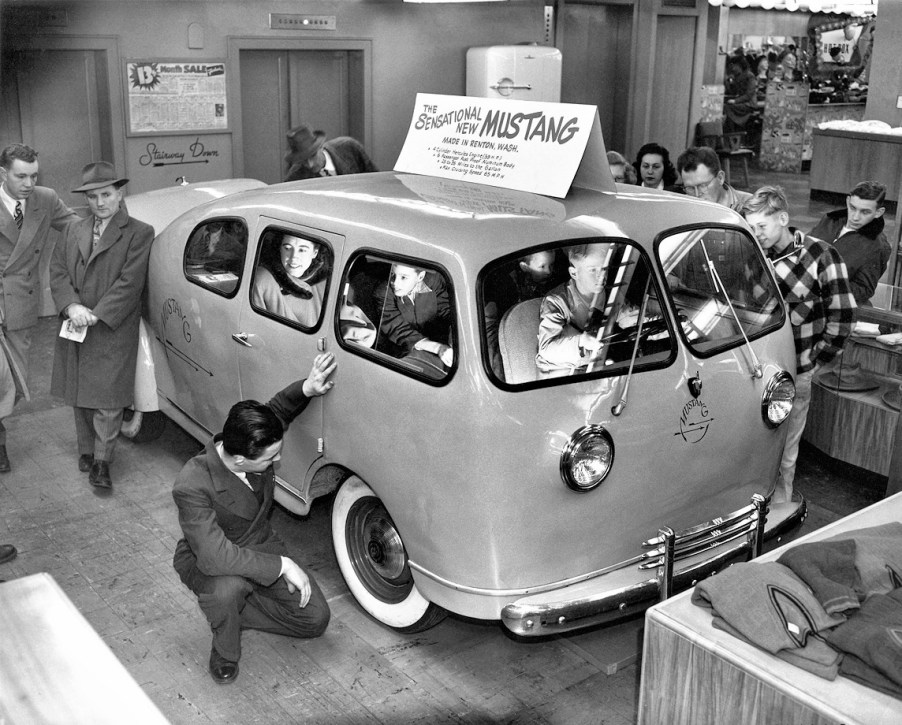
Yes, There Really Was A Mustang Teardrop SUV in 1948
There once was another Mustang. Way before the Ford Mustang we know and love. It, too, was an SUV just like the recently revealed Mustang Mach E. And it started in 1948, over 15 years before the Ford version. In fact, Ford was sued over the name because of this car.
Back in 1948 a Lincoln service manager from Seattle, Washington, wanted to build his own car. After the war, there were many attempts from enterprising entrepreneurs wanting to become automobile moguls. They mostly had some hair-brained ideas they thought would revolutionize the car-world.
The Mustang SUV came at a time of crackpots, crooks, and dreamers

Mostly these were crackpots, some were crooks, while others legitimately pursued their dreams. Roy McCarty was one of the latter. He had theories on building a cheaper, safer, yet better car than those rolling around America. Some of these ideas were good, too.
He wanted an aerodynamic design, with the engine situated in the back for better weight distribution. It also allowed for a better package to transport people. Through interesting ads and sales tools, he conveyed his ideas for the “Mustang.”
Without aerodynamic testing who knows whether the 1949 Mustang was actually superior

The “whale” body he came up with was based on sound aerodynamic principles, without the backup of wind tunnel tests, unfortunately. That means we’ll never know whether these were based in real advances or guesses rationalized to seem better. The “teardrop streamlining” somewhat mimics aerodynamic tests done in the 1930s. These showed that a sedan moving backward was actually more aerodynamic than going forward.

The safety aspect was also touted as being better than conventional vehicles due to better visibility. This was true but failed to mention the vulnerability of those riding up in front in the case of a head-on collision.
McCarty had some great ideas for his Mustang teardrop

McCarty wanted to build his car with existing components adapted to his unique vision. He decided that the steering from a Willys Jeep, a Continental or Hercules engine, and Spicer rear axles would be the basis for his car. Continental and Hercules would supply any manufacturer with their engines. They could be found in many 1940s vehicles. He figured that the existing components would be cheaper and take hardly any time to design and develop because they already existed. Plus, repair parts were readily available.
Though information is a bit sketchy, between one and 12 Mustangs were built. They were fabricated by Pacific Car and Foundry in Seattle. The bodies were made from aluminum which helped to promote the lighter weight and also the resulting fuel economy.
The Mustang Motor Company started issuing stock certificates

With at least a prototype running around to prove the concept McCarty tried to sell stock to fund production efforts. The Mustang Motor Car Company issued stock certificates throughout 1948 but in May 1949 McCarty resigned from the board of directors. This was the end of the enterprise but not the end of the story.
In November 1965, after the Ford Mustang was the sensation of the car world, McCarty filed a lawsuit against Ford for $10 million. He maintained he was currently in “engaged in design, development, and production of the Mustang.” If he actually had been it would be grounds for a lawsuit. But in trademark law, if you’re not using your trademark you can lose it. As there was no evidence that McCarty was doing anything with the name after 1949 he was on thin ground to make that claim.

There was a series of correspondence between McCarty’s attorney and Ford’s attorneys. Based on those letters it seems the case fizzled out by mid-1966 and nothing more came from it.
But there really was a Mustang SUV-like vehicle back in 1948. At least one example survives in a private collection today.



